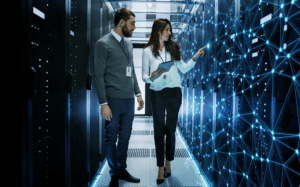As we kick off a new decade, it’s a great time to reflect on the evolution of data center management. Not long ago, all functions were manual and handled on-premise, but then came Data Center Infrastructure Management (DCIM) software, which delivered capabilities such as real-time monitoring and task automation to reduce the hardware footprint and improve uptime.
DCIM made the data center administrator’s job considerably easier by driving new efficiencies, but we are seeing even more improvements as the new decade begins. Next-generation DCIM is the next phase of the evolution of data center management and will further reduce downtime by providing real-time visibility across distributed environments.

What is Data Center Management?
But first let’s discuss what data center management is. When we talk about data center management, typically we’re referring to the responsibilities and processes associated with IT infrastructure management, including computers, servers, and networking equipment. Increasingly the data center management role also covers functions such as power, building systems, assets, and warranty management. The primary goal is to keep everything up and running with a set of tools and processes. One critical tool that enables data center managers keep up with this huge task is DCIM. According to Gartner, DCIM covers the following functions: “monitor, measure, manage, and control data center utilization and energy consumption of all IT-related equipment (such as servers, storage, and network switches) and facility infrastructure components (such as power distribution units and computer room air conditioners).”
As data center management has evolved, more tasks have become automated. If as an administrator you still use a spreadsheet every time you add a server or make a change in the data center, you’re not maximizing your time. And you’re likely increasing the chance of error, which can lead to unplanned downtime and the high costs of lost productivity.
Data Center Management Evolution
DCIM was first introduced about a decade ago. As workloads have increased — and the amounts of data processed in the data center exploded — trying to manage it all manually became unrealistic. DCIM makes data center management smoother and simpler by using software, hardware, and sensors to monitor critical systems from a central dashboard in real time. DCIM handles not only day-to-day tasks but also the management of change, capacity, and assets.
DCIM allows administrators to respond to problems more quickly, which prevents downtime, but in some cases an outage is unavoidable. With next-generation DCIM, however, the ability to prevent unplanned downtime increases substantially.
The main difference between DCIM and next-generation DCIM is that the new version runs in the cloud. As such, it is especially suited to running distributed IT environments that include centralized, regional edge, and local edge environments.
One of the main benefits of cloud-based DCIM is visibility. Now, administrators get round-the-clock monitoring with full visibility of the environment any time and anywhere. It also means being able to manage more with less, and providing data center managers with greater knowledge (product information, historical data, product usage profiles, etc.) so they can have better operational control.
Data is collected on power use and environmental conditions so administrators can make adjustments that reduce consumption. And because the solution is cloud-based, it helps reduce footprint. Through data collection, next-generation DCIM tracks threshold violations and issues alerts when action is required to avoid an outage.
How Next-generation DCIM Addresses Data Center Management Challenges
The result is less downtime and fewer errors. As such, next-generation DCIM is a proactive solution that mitigates risk and delivers peace of mind to data center administrators by addressing common data center challenges:
- Managing applications, hardware, and services from multiple vendors with different contracts, warranties, and update schedules
- Running multiple data centers that operate with different equipment and processes
- Monitoring performance to maintain required availability and uptime
- Managing change when systems and equipment need to be upgraded or replaced, and new services are implemented
Discover more about EcoStruxure™ IT, our next-generation DCIM solution, and how it can improve your data center operations — so you can make a robust case to your management team to invest in this technology.




Conversation
Data center management is definitely an important topic and it certainly has evolved over the years, the technology is advancing quickly to the point management is almost perfectly automated and streamlined. Thanks for this post!